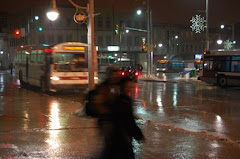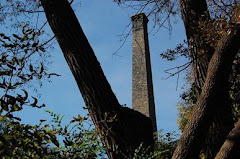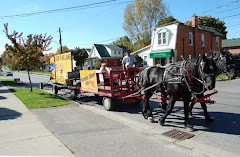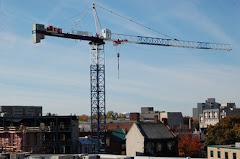On Friday morning, the City of Guelph officially began its charm offensive to get transit users ready for the new and amended schedules and routes being proposed for September. At a media brief, Transit General Manager Mike Spicer, Supervisor of Planning and Scheduling Nancy Button, and Route Performance and Scheduling Specialist Laura Catalano-Bragues answered questions about the initial phase of the realignment.
Spicer began by saying that when he arrived in Guelph, he challenged staff to look at routes and find out if Transit was providing the best service it could deliver with the resources that it had. This challenge began the process that led to this realignment.
"During the exercise it became very clear to all of us that the Gordon Street corridor was one area of the city where we needed to make some sort of change as we were leaving people on the sidewalk," he said. "Missing riders is not good for a transit system."
Spicer also reaffirmed that this realignment has nothing to do with growth, but rather making Guelph Transit serve the needs of the City right now and be prepared for future growth. "In order to look at any type of growth strategy that we'll be doing later this year, we needed to make sure that our network was in a very comfortable spot to be able to do that, and we wanted to make sure we were applying our resources in the best possible way that we could," he added.
So this isn't a growth strategy?
No, this is not a growth strategy. The main point of the realignment is to put buses places where there are people using them, and do it all within the constraints of the present budget. On the other hand, the Transit staff did phrase the addition of the 99 Mainline route as "a step towards rapid transit," which says that there are future considerations in the mix here. "This is one of the things that will help us grow the network," said Spicer. "Guelph seemed to have an awful lot of convenient routes that were not performing at the level we would like to perform, and we were not performing well in other parts of the city, and those resources weren't being managed well from an idea of moving people along."
Isn't Transit undergoing a Service Review later this year?
Yes, but Spicer said the changes need to be made because aforementioned problems of efficiency; leaving some people on the sidewalk in some parts of the city and having half-full buses in other parts. "What we're proposing that this will do is give us a base network that will always be our base network that people can learn and understand," said Spicer, "and then when we look at any future growth later this year, or how we're going to make changes, I think that's going to be a part of [the review]."
According to the plan I've got reduced service in my area, why?
By the numbers. This is a map developed from a month of data gathering showing where the averages for passenger boardings at bus stops are. The are two circles you can't see because they're bigger than the map: the University Centre and Guelph Central Station.
"Our goal is not to shaft anybody," said Spicer. "Our goal in this realignment was to provide resources to where they are needed. There are other parts of the city where we know residents are expecting some level of service, and that's where we will be able to expand because we see that need." If you're area is feeling underserviced by transit, Spider said that part of the service's research going forward will be to understand why.
Is Transit worried about people not getting the news that routes and schedules are changing?
Yes, which is why they're doing all this engagement, plus sharing the changes through the all the usual channels. When we get closer to September, they will also be handing out door knockers to homes in areas where bus service is either being removed or added.
What's the frequency of the five new routes going to be?
The 99 will run every 10 minutes weekdays, and will run at a reduced frequency on weekends. There's no exact word on what reduced frequency is going to look like, but it could be every 15 minutes on Saturday and every half hour on Sunday. The total length of the route from Walmart to Clair Road will be 40 minutes. The new 41 Downtown-University express route will be 10 peak in the morning and afternoon, and 15 minutes the rest of the day on weekdays, and reduced frequencies on the weekend, while the 40 Scottsdale Express will jun every 30 minutes on weekday afternoons. The 51 U Janefield with service the university morning, midday and afternoon, while the 52 U Kortright will just run in the morning and afternoon.
What kind of feedback have Guelph Transit operators given for the new routes/schedule?
They suggested the route renaming; there was a lot of confusion about which way A goes and which way B goes, for example. They also suggested that the platforms be reorganized at the University Centre,
and in September all northbound and westbound buses will park in the north loop while all the southbound and eastbound buses will park in the south loop. Operators also advised on where bus stops needed to be added or adjusted.
How many bus stops will be lost?
About 25 current stops will be removed, but according to Transit, many of them will be moved somewhere within close proximity to where the present stop is. Those numbers could change though.
And since we're changing stops, are we also going to be installing new shelters?
"We do have a plan in place, probably starting this spring, we will be adding more landing pads throughout the city, we have prioritized them based on where people are getting on and off the bus, but we've also prioritized them in areas that aren't that accessible," Spicer said. "That's all part of the PTIF (Provincial Transit Infrastructure Funding) that we're hoping to hear back pretty soon that we've been approved [for]."
Is Transit as concerned about over-capacity on the new 56 U Colonial as the people that posted on Politico are?
"We do have a Plan B if that were the case," explained Spicer. "We are receiving some additional buses this fall. Currently, we're running at capacity in terms of our fleet size, but there are opportunities where we're buying new buses for ones we're going to retire, and if we find that in the fall, we will report to city council that we're still leaving people behind and may need to get some additional operating funds. But we'll tackle that when we get to it."
What about the 1 and 2 (Edinburgh College)? Those morning and afternoon buses fill up pretty quick.
"I get that there's going to be of anxiety on this issue, but what I can tell you is that this will allow us to be more proactive than reactive and make the best decisions based on the boardings that we have right now," said Spicer. "I think we want that feedback, we want to know where the pain points might be, and we're going to monitor that, look at that, and if we can't get ahead of that, then we can respond very, very quickly."
"For the 1 and 2, the 51 U and the 52 U operate in the morning and the afternoon, both of them, those are offset with the 1 and 2," addd Catalano-Bragues. "On peak before with the 1A and B you would get three buses, but now you actually get four."
How close is Trapeze to being fully-functional?
Spicer said it's been delayed for a number of reasons, and that a system like this is fairly complicated to implement. However, "I think it's almost there," he said. "I think by the end of the year it will be fully operational and functional. The customer facing part will be coming up later this year with real time information, apps will be available, and all of that. But getting the background information was our priority so we can make these changes with the supporting data."
Any chance that we'll get expanded service on the weekends?
"I will tell you that's the one area we need to improve our frequency and our service is on the weekends," said Spicer. "If we're going to promote this as a base level service, we're a seven day operation, not a five day operation, and if people are going to rely on us and commit to us, then we have to give them a level of service that meets their needs."
Any update on regional transit?
"As part of the service review in the fall that's where we're going to land that airplane, but we're definitely getting a lot of pressure for us to look at regional transit, so I think my commitment is to start those discussions, make them formal, and come up with a plan that will come up with some sort of horizon," Spicer said. He's already talked to Metrolinx, he will soon be talking with Grand River Transit, but those aren't the only regional transit expansions Spicer's looking at. "We see Fergus as a great opportunity for us to feed more and more people into the city form that area."
What happens next?
There are the four sessions happening next week, and people can also give feedback via Transit's social media feeds and by phone and email. Public feedback, according to Spicer, is very important to making these changes work, and work for everyone. "We're going to take all the feedback we receive, and actually decipher it, and find out if we need to make any tweaks," he said. "We also wanted to as transparent as we could in regards to the public. We've learned some lessons in the past that we probably should have done a better job in communicating with them."
The public feedback sessions will be on the follow days, times and locations
Monday, March 27 3:30–7:30 p.m. Salvation Army Guelph Citadel
Tuesday, March 28 3:30–7:30 p.m. Willow West Mall
Wednesday, March 29 3:30–7:30 p.m. City Hall, Room 112
Thursday, March 30 Noon–5 p.m. University of Guelph, University Centre
For the original Politico story on schedule click here, and more the information posted on the city website click here.



















No comments:
Post a Comment